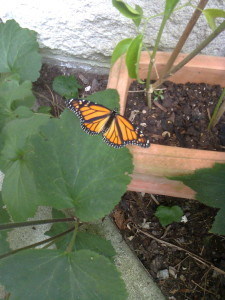Monarch butterflies are an iconic New Zealand symbol of summer. It’s irrelevant that these floating and fluttering orange and black delights are apparently North American interlopers, blown across the Tasman Sea via Australia through the stratosphere unaided by Emirates or Air New Zealand.
 So much part of our New Zealand identity is the Monarch that large and kitsch versions adorned suburban homes. The Monarch’s importance is exemplified by the work of the Monarch Butterfly New Zealand Trust, dedicated to the continuing existence and rescue of the butterfly, and the regular appearance of swan plants, the Monarch’s primary food source for sale in local markets.
So much part of our New Zealand identity is the Monarch that large and kitsch versions adorned suburban homes. The Monarch’s importance is exemplified by the work of the Monarch Butterfly New Zealand Trust, dedicated to the continuing existence and rescue of the butterfly, and the regular appearance of swan plants, the Monarch’s primary food source for sale in local markets.
Prior to Christmas the delightful James at the Historic Village Market presented me with two swan plant seedlings. Beautifully potted they remained in their containers resting on a memory block outside my front door. I guiltily admit, seasonal demands left them there.
Then rock the socks – there’s a caterpillar – relative to the size of the plants an enormous caterpillar – on the small and fragile plants. With locust-like terrifying speed the plants are reduced to small and sad twigs. The large and terrifyingly coloured black and yellow caterpillar marine-like is on the march for more fodder. It methodically explores the adjacent environment. Again relative to its size, it walks miles and miles in search of food. No the huge Japanese Anemone leaves in the adjacent garden don’t appeal. It eventually goes back to the swan plant stumps.
 What to do? No self-respecting Kiwi would not assist a Monarch butterfly. It would be eating the last sausage roll or scoffing all the tomato sauce at the school barbeque. Like all children of my vintage, I know the life-cycle of the monarch butterfly. We did it at school. And what’s the most important thing school taught me – in the event of the decimation of the swan plant, offer pumpkin. So that’s what I did. Unfortunately this pumpkin most probably wasn’t big enough or ripe enough for this particular caterpillar. It spent some time either on it or around the pumpkin as attested by identifiable minute deposits of ….but didn’t consider it an alternative home or source of nourishment.
What to do? No self-respecting Kiwi would not assist a Monarch butterfly. It would be eating the last sausage roll or scoffing all the tomato sauce at the school barbeque. Like all children of my vintage, I know the life-cycle of the monarch butterfly. We did it at school. And what’s the most important thing school taught me – in the event of the decimation of the swan plant, offer pumpkin. So that’s what I did. Unfortunately this pumpkin most probably wasn’t big enough or ripe enough for this particular caterpillar. It spent some time either on it or around the pumpkin as attested by identifiable minute deposits of ….but didn’t consider it an alternative home or source of nourishment.
Suddenly, there’s no caterpillar. I’m bereft. I’ve failed in my Monarch butterfly responsibility. I’m also embarrassed that I didn’t do more. Could I have called the Monarch butterfly trust for a helicopter rescue of the caterpillar? Should I have driven it uptown to the SPCA? Should I at least have had Colin the district Netetary (online secretary) put out an urgent plea for an alternative swan plant home? Too little, too late. It’s gone.
Then the brain re-engages: I remember one of the interesting features of the Monarch caterpillar is that it looks like it does to deter predators and then from the recesses of the brain I recall that birds don’t eat them because they taste foul! Carefully I start to look around the adjacent Japanese anemones. There it is a tiny green and gold spotted chrysalis underneath a large leaf. I feel partially redeemed although most probably the inherent sense of self-preservation of the caterpillar prematurely directed it to this stage of its development.
 I don’t remember how long the chrysalis phase is supposed to take but suddenly there’s a very small Monarch butterfly drying its winds on an anemone leaf. I watch, as I did as a little girl, as the wings open and close until at last its gone. Like the summer that is slowly inching its way from Whakamarama, my butterfly has gone. No goodbye.
I don’t remember how long the chrysalis phase is supposed to take but suddenly there’s a very small Monarch butterfly drying its winds on an anemone leaf. I watch, as I did as a little girl, as the wings open and close until at last its gone. Like the summer that is slowly inching its way from Whakamarama, my butterfly has gone. No goodbye.
And then there’s more of them. I see a large monarch gliding over the driveway hedge. Is it the same one that was fluttering outside the dining room? Who knows. It’s been a butterfly year – beautifully marked white butterflies, that eternal pest of the gardener. The small black and white spotted butterflies we used to collect as children. And tiny little Monarch reminiscent flutters occasionally appearing on the flowers or in the herb garden. Is it the weather or is it the beds of flowers growing next door?
While I’ve enjoyed their presence and marvelled at the life cycle of the Monarch I’ve been reminded of the rapid destruction insects can do. The swan plants disappeared with terrifying speed and whatever, overnight vacuums, the leaves off the lemon balm reinforces the need for vigilance and balance. No I’m not advocating agrichemicals or genetically modified anything. I think I’m just reminding myself of the power of the caterpillar.
The Monarch Butterfly New ZealandTrust can be found at www.monarch.org.nz
 Rosemary Balu. Rosemary Balu is the founding and current editor of ARTbop. Rosemary has arts and law degrees from the University of Auckland. She has been a working lawyer and has participated in a wide variety of community activities where information gathering, submission writing, community advocacy and education have been involved. Interested in all forms of the arts since childhood Rosemary is focused on further developing and expanding multi-media ARTbop as the magazine for all the creative arts in the Bay of Plenty, New Zealand.
Rosemary Balu. Rosemary Balu is the founding and current editor of ARTbop. Rosemary has arts and law degrees from the University of Auckland. She has been a working lawyer and has participated in a wide variety of community activities where information gathering, submission writing, community advocacy and education have been involved. Interested in all forms of the arts since childhood Rosemary is focused on further developing and expanding multi-media ARTbop as the magazine for all the creative arts in the Bay of Plenty, New Zealand.




